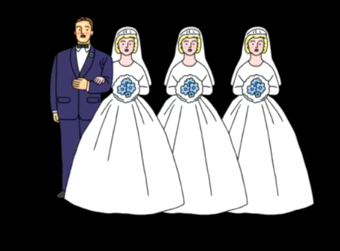Mesopotamian prayers included blessings for such couples,
美索不達米亞的禱文中包括了為同性夫妻進行祝福,
while Native American Two-Spirit individuals had relationships with both sexes.
而美洲印第安的雙靈人與兩種性別的人都會發生關系。
The first instances of such arrangements actually being called "Marriage" come from Rome,
首例同性婚姻被實際稱作為“婚姻”的情況出現在羅馬,
where the Emperors Nero and Elagabalus both married men in public ceremonies with the practice being explicitly banned in 342 A.D.
皇帝尼祿和埃拉伽巴路斯二人都以公開典禮的形式與男性結婚,這種行為在公元342年被明令禁止。
But similar traditions survived well into the Christian era, such as Adelphopoiesis, or "brother-making" in Orthodox churches,
但是,類似的傳統在進入公元后幸免于難,比如滴血為盟,或者傳統教會中的兄弟結拜,
and even an actual marriage between two men recorded in 1061 at a small chapel in Spain.
甚至是兩個男人之間實質的婚姻,在1061年西班牙某個小禮堂的記錄中都有所記載。
Nor was marriage even necessarily between two living people.
婚姻甚至都不一定需要發生在兩個活人之間。
Ghost marriages, where either the bride or groom were deceased, were conducted in China to continue family lineages or appease restless spirits.
冥婚,就是新娘或新郎已經過世,它曾在中國出現過,主要是為了延續家族香火或者安撫死不瞑目的靈魂。
And some tribes in Sudan maintain similar practices.
另外,蘇丹的一些部落延續了相似的情況。
Despite all these differences, a lot of marriages throughout history did have one thing in common.
盡管有這些五花八門的差異,但古今歷史中的許多婚姻也的確有一個共同點。

With crucial matters like property and reproduction at stake, they were way too important to depend on young love.
一些決定性的因素,比如財產和至關重要的傳宗接代的問題,這些因素都太重要了,以致于婚姻無法只取決于脆弱的愛情。
Especially among the upperclasses, matches were often made by families or rulers.
尤其在上流社會,配偶的人選常常由家庭或者統治者來決定。
But even for commoners, who had some degree of choice, the main concern was practicality.
即使對于有一定選擇權的普通百姓,主要的考量還是實用性。
The modern idea of marriage as being mainly about love and companionship only emerged in the last couple of centuries.
現代婚姻的理念,主要圍繞著愛和友誼,這種觀念僅僅是在過去的幾個世紀才出現的。
With industrialization, urbanization and the growth of the middle class more people became independent from large extended families and were able to support a new household on their own.
隨著工業化,城市化以及中產階級的涌現,越來越多的人從龐大的家族中獨立出來,并且有能力自己負擔一個新的家庭。
Encouraged by new ideas from the Enlightenment, people began to focus on individual happiness and pursuits,
受到來自于啟蒙運動中新思想的鼓舞,(對于婚姻)人們開始更加注重個人的幸福和訴求,
rather than familial duty or wealth and status, at least some of the time.
而不是家庭責任或財富地位,至少有些時候是這樣的。
And this focus on individual happiness soon led to other transformations, such as easing restrictions on divorce and more people marrying at a later age.
而這種對個人幸福的放大很快導致了其他方面的轉變,比如放寬對離婚的束縛以及晚婚率的增加。
So, as we continue to debate the role and definition of marriage in the modern world,
所以,隨著我們進一步討論婚姻在現代社會的角色和定義,
it might help to keep in mind that marriage has always been shaped by society,
也許我們應謹記婚姻始終都是社會的產物,
and as a society's structure, values and goals change over time, its ideas of marriage will continue to change along with them.
而隨著社會的結構,價值觀和目標的不斷改變,其對于婚姻的定位也會隨之不斷進行著調整。


